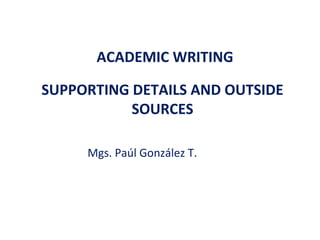
Supporting details and outside sources
- 1. ACADEMIC WRITING SUPPORTING DETAILS AND OUTSIDE SOURCES Mgs. Paúl González T.
- 2. SUPPORTING DETAILS: FACTS, QUOTATIONS, AND STATISTICS Academic writing normally requires that you support your ideas and opinions with facts, statistics, quotations, and similar kinds of information. It is possible for you to get these kinds of supporting details from outside sources such as books, magazines, newspapers, web sites, personal interviews, and others.
- 3. USING OUTSIDE SOURCES Where can we find specific supporting details to support our ideas? Personal experience Gather quotations and statistics by performing an experiment, taking a survey, or interviewing people In the library On the Internet
- 4. There are three ways to insert outside information into your own writing: 1.We can quote it 2. We can summarize it 3. We can paraphrase it
- 5. PLAGIARISM • It is using someone else’s words or ideas as if they were our own, and it is a serious offense. • When we use information from an outside source without acknowledging that source, we are guilty of plagiarism. • One way to avoid plagiarism is to always put quotation marks around words that you copy exactly. • We are guilty of plagiarism if we fail to cite the source of outside information even if we are paraphrasing
- 6. Citing a source means to tell where you got the information. Citing a source is a two-step process: Insert a short reference in parentheses at the end or at the beginning of each piece of borrowed information. This short reference is called an in-text citation. She stated, "Students often had difficulty using APA style" (Jones, 1998, p. 199), but she did not offer an explanation as to why.
- 7. Prepare a list describing all our sources completely. This list can be titled “References” or “Works Cited” and appears as the last page of your paper. Duncan, G. J., & Brooks-Gunn, J. (Eds.). (1997). Consequences of growing up poor. New York, NY: Russell Sage Foundation.
- 8. QUOTATIONS A quotation can be a sentence, several sentences or a short paragraph. Quotations from reliable and knowledgeable sources are good supporting details. There are two kinds of quotations
- 9. Direct: We copy another person’s exact words and enclose them in quotation marks. Satzke states that: "Plagiarism is the theft of someone else's words." (2001, p 17) Indirect: We report what other person said without using quotation marks. Satzke (2001) points out that plagiarism is a form of theft.
- 10. If we want to introduce borrowed information we can use the phrase according to or a reporting verb such as: assert declare maintain report claim insist mention say write suggest state
- 11. STATISTICS They are good supporting details which can be used with the previously mentioned reporting verbs when citing.
- 12. THANK YOU
